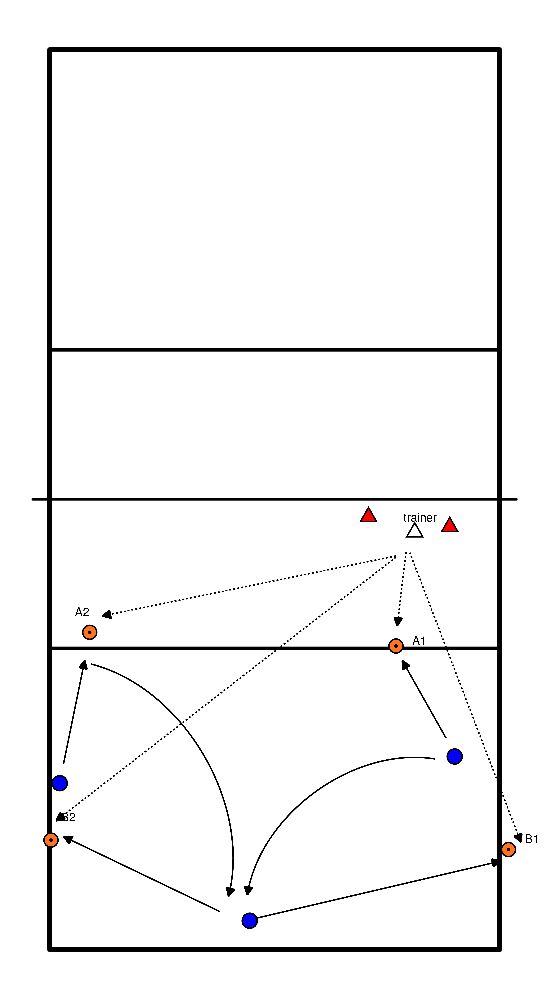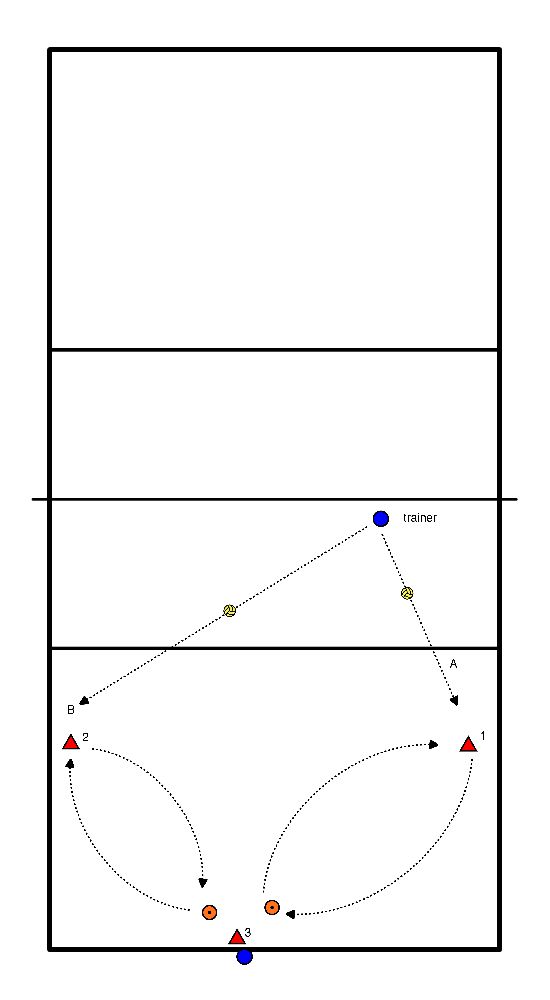Volleyball drills for technique warming-up
- The first student picks up the second and they have to return to the starting point with the hoop around their waists.
- Nr 1 holds the wall with one hand.
- Nr 2 picks up nr 3 and holds on to nr 1.
- And so on.
- When everybody is picked up, a long chain is formed and everybody has to try to get through the hoop.
- Each player has a sit up ball - 9 different core-stability exercises
- The Grasshopper:
- To get the most benefit from this exercise, make sure your body is in a straight line from head to toe, your hips are square (parallel to the ground) and your abs are tucked in and braced.
- Your hips should not sink at all during the movement, especially when you return to full length from the knees inwards.
- Another important point is to make sure your shoulders fall over your hands at all times, so your body doesn't rock back and forth, largely losing the benefit of this stability ball exercise.
- If you have sensitive wrists, use a pair of dumbbells as a base for your hands, this will keep your wrists in a more neutral position and reduce their strain.
- Push ups:
- Keep your hands on the side of the ball so your wrists are more neutral and very slowly lower to the ball to make this a good challenge.
- Just before your torso hits the ball, explosively (yet controlled) push back up.
- Straight Leg Deadbug:
- To get the most out of this exercise, make sure your arms and legs are always pressed into the ball.
- Even if you extend one arm and leg to just above the ground, the leg and arm still holding the ball should be pressed into the ball.
- Back leg position:
- Place your arms to the side or under the lower back if more support is needed there.
- Start with your legs perpendicular to the ground and on either side of the ball.
- Then rotate your legs so that your right leg is in front of the ball (facing you), while your left leg is on the other side (facing away from you).
- Pause at the end of each turn and then turn again so that the legs are reversed.
- Hamstring Roll-Ins:
- The key is to keep your hips high the entire time, so that your body is in a straight diagonal line from your feet to your head.
- Dig your heels into the ball as you drag it back to your buttocks.
- Squeeze your hamstrings and return SLOWLY to your legs fully extended (remember to keep your hips up).
- Ball Sensitive Twists:
- Start with your hands on the ground, shoulders above your hands, abs braced, body in a straight line and feet on either side of the ball, activating your groins to keep your legs from slipping.
- This alone is a huge benefit.
- Next, slowly rotate your hips to the right so that your foot touches the ground.
- Use your obliques to pull your hips back square and then to the other side.
- Remember to keep your hips at shoulder height the entire time.
- Ball Planks:
- Here I want you to dig your forearms and especially your wrists into the ball.
- This alone will increase your core activation 10-fold.
- Tighten and brace your abs, keep your hips up, and glutes and quads contracted.
- Next, simply move the ball around in a small circular motion, moving only your arms.
- Your whole body should stay still like cemented concrete.
- Lateral Scratch Runs:
- The ball should be under your head and shoulders and feel like a pillow, while your arms are stretched out to the side and fully locked/contracted.
- As with all of these stability ball exercises, the key with this one is to make sure your hips are up and your body is in a straight line from your knees to your shoulders.
- Push-Ups:
- This is a pretty easy move as you go down and pull your knees towards your wrists.
- This, of course, also causes the ball to roll inward.
- But the real test begins when you push yourself out of this "tucked in" position. Try it and convince yourself.
- Short/long.
- Trainer throws ball to position A1.
- Player 1 passes the short ball and runs to the middle.
- Trainer throws ball to position B1.
- Player 2 tries to pass ball back from A2, and gets ready for ball on A1.
- Then trainer switches to the other side.
- Trainer throws ball to A2.
- Player 2 passes the short ball and runs to the middle.
- Coach throws ball on to B2.
- Player 1 tries to pass ball on B2, and stands ready for ball on A2.
- Other players?
- Three get balls.
- 3 encourage.
- After 10 balls, change groups.
- 2 trainers available?
- 1 trainer makes sure the player in the middle does not cheat by starting too fast. (and keep him/her in the middle).

- Players have a ball and dribble down the hall.
- On command, they throw the ball up and catch it.
- On command they throw the ball to a buddy.
- On command they throw the ball up and must pancake.
- On command they throw the ball in front of them and have to dive for the ball.
- For each command a different command. after the command they keep dribbling.
- 1 player stands in the field and gets 10 balls from the trainer.
- Balls must at least be touched but the focus is on quick movement, being ready and passing overhead/underhand. (trainer makes sure balls can be hit).
- Other players stand around the field and make sure balls get to the trainer.
- And of course encourage the player who is doing the exercise.
- Short/long.
- Trainer throws balls to the 3 meter line. (positions A + B)
- Player 1 passes the short ball and runs to the middle.
- Player 3 comes in to play the ball.
- Then trainer switches to the other side.
- Player 2 plays the short ball, and goes to the middle.
- Player 1 now goes for the ball on the other side.
- Other players?
- 3 get balls.
- 3 encourage.
- After 10 balls switch groups.
- 2 trainers available?
- 1 trainer makes sure the player in the middle does not cheat by starting too fast. (and keep him/her in the middle).

- Three teams.
- Trainer. (white triangle)
- Players. (red triangle)
- Trainer throws balls towards the backfield.
- Players do not run from the net until the trainer throws.
- Players try to get the ball over the net 3 times.
- Change with 3 new players.

- On each half of the pitch there are 2 benches, in the width of the field.
- Start with slalom around the benches, from half court to half court and back again.
- Instead of walking between the benches, do the connecting pass with the bench.
- Idem cross pass.
- Jump over the benches.
- Balancing over the benches:
- Move left and right leg next to the bench.
- 1x 2-person and 3x 3-person per bench.
- Skip step alternately.
- 2 feet equal.
- Li/re on, li/re off.
- Various other exercises.
- 4 benches, in pairs to the other side, next pair can as soon as the first bench is free.
- Each pair starts on the other side of the same bench.
- Walk across the bench, pass each other in the middle.
- Walk along the bench, jump in the middle and clap hands together, then the next bench.
- Everybody hops over the bench 4 times with hands on the bench. (move towards each other)
- Each a ball, walk over the bench, pass each other in the middle, while bouncing the ball.
- Bounce the ball, walk along the bench, jump in the middle and clap hands together.
- One ball in pairs, each on one side of the bench.
- Pass the ball while going from right to left (always closer to the middle and then further away again).
- Move sideways.
- Idem one side underarm return.
- Play one side overhead.
- 2 teams make sure you throw the players of the other team.
- You are not allowed to run with the ball, fend off the volleyball way or head on.
- Hitting someone on the ground is not allowed.
- If you are the only player left, you may dribble the ball.
- Objective:
- Develop ball sense, be able to control ball close to your body.
- Everyone has their own ball, can be combined with a warm-up.
- Let the ball bounce on your right fist.
- Up to maximum eye level.
- Arm is stretched out and is almost horizontal.
- Stay in one place as much as possible.
- Later on, alternate bouncing with your left hand.
- Now do the same while following the yellow lines in a certain pattern.
- The person in front chooses the route (watch out for rear-end collisions!); who wants to take this role? (requires even more concentration and a sense of responsibility a la captain's role)
- Play the ball with only your right hand above your head, up to a maximum of 30cm higher than your hand
- Your upper arm is pointed 45 degrees upwards and your forearm 45 degrees in the other direction; this brings your hand above your shoulder again.
- The ball is played mainly with your wrist and forearm; stay in one place as much as possible.
- Later on, alternate with the left hand.
- Afterwards also in pattern.
- Play the ball in a fixed routine for yourself, for example:
- Square:
- Underhand R, overhand R, overhand L, underhand L, underhand R, ...etc. (change later to the right)
- Cross:
- Lower hand R, upper hand L, upper hand R, lower hand L, lower hand R, ...etc.
- In teams of four (preferably) with each its own ball.
- Stand in a square; all equally spaced.
- Throw the ball to the next person and catch the ball that is thrown to you.
- First throw underhand and catch underhand; then throw abovehand and catch abovehand.
- Then expand by passing 1 ball.
- Choose a spot opposite the wall.
- Sit in front of the wall with your feet against the wall.
- Play overhead against the wall. (Ball just above eye level)
- Pay attention to the movement of the wrist and a little bit of the forearm.
- The ball will only bounce about 10cm this way.
- If necessary, extend the game by slowly standing up, playing standing up for 10 seconds and then sitting down again.
- Let them play a route along the wall: bounce briefly (10cm) and play overhand (right).
- At the end of the route, take a distance of 2 meter from the wall and keep on playing overhand while walking left until the beginning of the route, close to the wall.
- Everyone in line; if you lose the ball, pick it up and go back to the line.
- All players are spread over the playing area.
- One player starts as the "hunter" and one player as the "prey".
- The "hunter" tries to catch the "prey".
- The "prey" can escape by running away or lying down next to another player.
- This player now becomes the "hunter" and the old "hunter" becomes the "prey".







